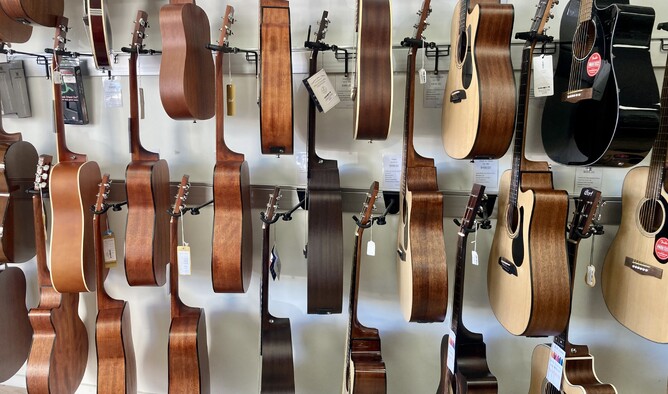Buying a new acoustic guitar can be scary, but it doesn’t have to be! Knowing just a little bit of information you will be able to cut through the jargon and make an informed decision.
The first thing to ask is “who is it for?”. This is because a 9-year-old needs a very different guitar to an adult looking to get back into playing. And that is different again for someone looking to start gigging or joining a band.
For students up into teens nylon string (classical) guitars are the best option. Nylon strings have lower tension than steel strings which makes them easier to push down. They’re usually cheaper than a steel string or electric guitar, so are less of an investment up front. There are typically fewer options in the nylon string range than steel string, but you usually have a bunch of fun colours to choose from to reflect the personality of the student!
For a teenager or adult looking for a first guitar I would recommend a steel string guitar. Steel string guitars sound ‘right’ which encourages older students to continue. The steel strings we stock are set up so the strings are low and easy to push down – particularly compared to many older guitars.
3 things typically contribute to the cost of pretty much anything: who makes it, the quality of the components it’s made from, and what features it has. These are all very important and contribute to your decision making. I’ll go into each here but will put a ‘too long, didn’t read’ at the bottom:
- Who makes it? This looks specifically at the manufacturer – not country of manufacture. I have seen incredible makers from many countries! There is a reason why famous brands like Martin, Fender, Yamaha, Ibanez and Cort are the biggest selling instruments worldwide. They consistently make great guitars that last. You may pay slightly more for them than a random unknown brand but there’s a good reason for that. While there are exceptions with some excellent smaller brands popping up, if you’re unsure you won’t go far wrong with one of those brands. They’re a great place to start your search.
- What about quality? I’ll go into the difference between solid and laminate woods some other time, but this is the biggest contributor to sound quality and price. Solid wood almost always sounds better than laminated (ply) wood. Better hardware means the guitar stays in tune better and these parts will last longer. A name brand pickup, like Fishman or LR Baggs, sound better plugged in and are a must if you’re wanting to gig.
- What features does it have? Typically, the acoustic/electric version of a guitar model is $100-$200 more expensive than the acoustic version. To fit an equivalent quality pickup after it leaves the factory would be around $350-500. A cutaway gives you the ability to play further up the neck. This costs more than a non-cutaway, partly because cutaway guitars normally have a pickup in them also. If those things aren’t important, you can save a bit of money!
Tl;dr
- A decent entry level nylon string guitar is $130-$250 (e.g. Valencia, Cort or Yamaha)
- A decent entry level steel string guitar is $250-$350 (e.g. Cort or Tanglewood)
- A $400-$600 guitar will usually have a solid top (usually sounds better) and if it has a pickup, this is usually a brand name like Fishman, which will sound better plugged in. This is a popular bracket for customers wanting to upgrade from their first guitar or wanting to do it ‘right’ the first time. (e.g. Fender, Cort, Sigma, Lag)
- To get a pro level guitar to gig with you’re looking at a Martin or something similar and these are typically $1500+ and quickly head up to $3000-$6000.

